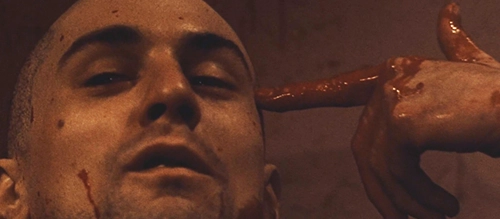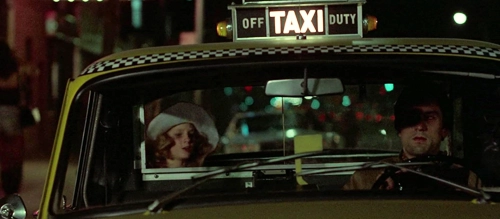Taxi Driver (1976) Review

Taxi Driver (1976)
Director: Martin Scorsese
Screenwriter: Paul Schrader
Starring: Robert De Niro, Jodie Foster, Cybill Shepherd, Albert Brooks, Harvey Keitel
On a steamy street in New York on a hot summer night, a cab pulls into frame, followed by an intense shot of eyes bathed in neon light and a psychedelic rendering of the city’s ceaseless hustle and bustle. The American New Wave, or New Hollywood, was brimming with films that brought arthouse sensibilities to the American mainstream, and Martin Scorsese’s neo-noir crime thriller is among the best. More than a vehicle for star Robert De Niro, Taxi Driver represents a convergence of genre and style from across place and time, painting a dreary picture of its contemporary America that still resonates today.
Taxi Driver was the second of Scorsese’s films to feature Robert De Niro, and it’s the movie that really put Scorsese on the map as the best filmmaker of the “auteur generation” – the group of 70s American filmmakers who grew up loving and studying film in a way their predecessors hadn’t. By 1976, Scorsese had made Boxcar Bertha and Mean Streets, and his film Alice Doesn’t Live Here Anymore had been nominated for Oscars. But Taxi Driver took his career to another level, scoring him the Palme d’Or at Cannes and another round of Oscar nominations.
The story, written by Paul Schrader, follows a Vietnam veteran named Travis Bickle who tries his hand at driving cabs. He is tortured by an inability to sleep and a lack of human connection beyond what he sees on TV or in a porno theater, which drives him to derangement, causing him to direct his inner conflict outward through violence.
While Travis is not a character to be admired, he is certainly one audiences can sympathize with. He’s socially awkward, demonstrated by his early encounters with Cybill Shepherd’s Betsy, a worker on a Presidential campaign staff, and a talk with fellow cabbie Wiz, to whom Travis can’t quite explain his feelings of estrangement. In his search for connection, he stumbles upon a child prostitute played by Jodie Foster, and feels a misplaced sense of patriarchal protection for her. It’s through Foster’s character that Travis ultimately finds his outlet for his angst, creating a moment that challenges our preconceptions of heroics. His views, however, expressed through his journal, are abhorrent, filled with racist rhetoric and descriptions of New York’s citizens as scum and vile.
But De Niro plays such a morally complex character to a T. De Niro is widely recognized for his charm, so it’s quite interesting to see him adapt himself to fit Travis’ socially inept characteristics. He has an ability to utilize his charisma as a front, like when Travis initially seduces Betsy, leaving viewers all the more embarrassed on his behalf when he doesn’t understand why she was upset he brought her to see a porno on their first date. De Niro captures Travis’ sense of alienation and impotence, but finds a way to humanize him. Part of the authenticity of Travis comes from Scorsese allowing improvisation, particularly with De Niro. Arguably the film’s most famous scene is entirely improvised, as De Niro stands before a mirror and says, “You talkin’ to me?”

Jodie Foster really steals the show in her role, one that had to be approved and monitored by child welfare professionals. She rehearsed and improvised with De Niro around New York, and feels entirely authentic and bright within the film despite the dark nature of her character. In one of her best scenes, she has breakfast with Travis at a diner wearing hilarious green sunglasses, and her teenage self is finally allowed to be expressed. She eats a jelly and sugar sandwich while Travis goes on about how she needs to be home with her parents, and in typical teenager fashion she calls him a square and starts talking about how she and her pimp get along because they’re both Libras. Speaking of her pimp, he’s played by Harvey Keitel in a wig sporting a ten-gallon pimp hat, and while it’s understandable why he doesn’t play a larger role, Keitel’s performance makes you wish he did.
Taxi Driver also serves as a symbol of the convergence of commercial American filmmaking, European new waves, classic Hollywood auteurism, and exploitation films. The film borrows from The Searchers through the protagonist’s quest to save a woman who may not want to be saved, and there are direct visual allusions to Psycho through an overhead tracking shot in the finale, drawing parallels between Travis and Norman Bates. A shot onto dissolving alka-seltzer has been compared to Godard’s Two or Three Things I Know About Her, and clearly functions as a symbol of Travis’ simmering violence. It also features raw, unbridled violence that had been traditionally reserved for Italian horror and Corman flicks. The shot of Murray Motson’s mangled hand, an effect created by Dick Smith, and the spurts of blood from Travis and others elevated cinematic violence from The Godfather to a more intimate level.
Taxi Driver is also notable for being the final film score from legendary composer Bernard Hermann, best known for Citizen Kane and Psycho. His score creates the neo-noir atmosphere as Travis prowls the streets of New York for fares. Perhaps the best of the score is the music of the dramatic finale, punctuating the bloody shootout. It’s a classic, studio-era type of sound with tense horns, oscillating strings, and foreboding timpani drums. It’s a beautiful piece that gives audiences the sense of slipping into a dream, causing one to wonder if the scene or the film’s epilogue are even real. Hermann passed mere hours after completing the score, which earned him a posthumous Oscar nomination.
Through a modern lens, one might wonder what the value of Taxi Driver is? Its perspective from a nihilist racist feels particularly useless in a post-Trump world, where we seem to be constantly subjected to the inner thoughts of the more deplorable denizens of society. There’s an entire rant in the film, delivered by Scorsese (standing in for an injured actor), about shooting a woman in her vagina for having an affair with a black man. The value lies in its indictment of society’s treatment of men, how the structural patriarchal forces that create the idea of masculinity fail to truly care for America’s men, and how that leads to them finding inappropriate outlets for their feelings because they don’t know how to express themselves. America is still facing the problem of disaffected men turning to violence against women, or larger forces like schools or churches, and we seem to be out of ideas for how to solve it. Taxi Driver doesn’t offer solutions, but clearly elucidates the problem in incredible cinematic fashion.
Taxi Driver’s legacy may not endure. It was great for its time and place, but Scorsese is more popularly associated with Goodfellas and Casino, which feature two other spectacular De Niro performances. But Taxi Driver is an essential film when examining the career of Scorsese and De Niro, and the American New Wave. Its darker themes, violence, and style make it a landmark work in the history of American cinema.
Score: 21/24
Recommended for you: Where to Start with Martin Scorsese

